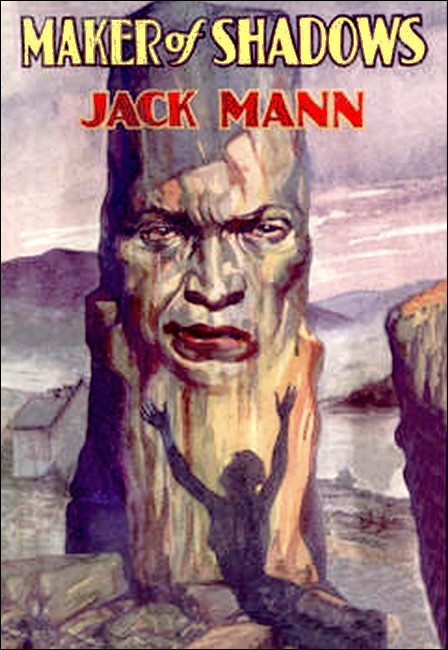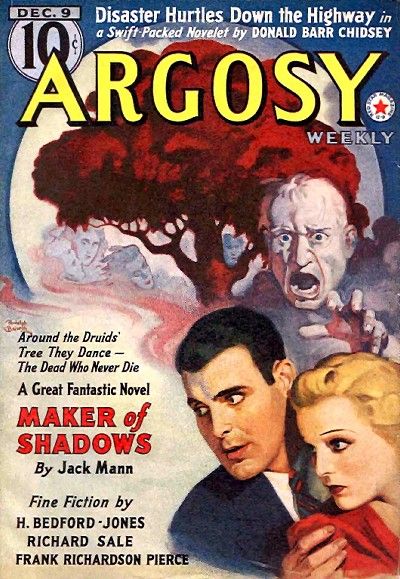 Charles Henry Cannell (1882-1947) is a writer better known for some lost race novels as “E. Charles Vivian.” He also wrote eight novels in the “Gees” series as “Jack Mann” published from 1936 to 1940.
Charles Henry Cannell (1882-1947) is a writer better known for some lost race novels as “E. Charles Vivian.” He also wrote eight novels in the “Gees” series as “Jack Mann” published from 1936 to 1940.
Maker of Shadows is the fifth novel in the series. Originally published in the U.K. as a hardback in 1938, the pulp magazine Argosy reprinted it in 1939 as a four part serial. Private investigator Gregory George Gordon Green known as “Gees” has a tendency to get involved in fantastic cases. He is traveling in the Scottish Highlands to a place called The Rowans at the request of Margaret Aylener. Gees has a difficult time driving through a dense fog you can see only a few feet in front of the car. The fog does not pentrate the territory maked by four rowan trees at the Aylener house.
Things get interesting in a discussion with the servant Callum:
“You know, probably,” Callum went on, “that this corner of the earth is still peopled by a branch of the Turanian race, to some extent. There is Gaelic admixture, but you can see Turanian in me, and it is stronger in Gamel MacMorn. Almost pure breed, there, no Gael blood showing. Ayleners are Brythonic—British, that is. They were a strong family, once, and now only two remain.”
“And they have been here how long?” Gees asked.
“Since Agricola’s wall was built,” Callum answered. “There is Gaelic blood in the family, of course—Goidels and Brythons were one race, at first, and Brythons held as far north as the site of Agricola’s wall before that wall was built. Ayleners were established here then, and how long before I do not know, and they held on here after the wall was built—held on after the Picts reoccupied Bernicia, and Hadrian’s wall was built as the limit of Roman power.”
“Where do your MacMorns come in?”
“MacMorns came near to establishing a Pictish kingdom,” Callum answered. “If they had had better material to their hands, they might have put an end to Roman rule, even, but the very thing that gave them their power, the practice of the old wisdom, spoiled the cohesion of the Picts.
“It was too bloodthirsty—you cannot rule altogether by fear. And so the power of the MacMorns was not enough—Hadrian’s wall held the Picts in spite of MacMorns, and the invasions of the Ulster Ivernians put an end to MacMorn supremacy.
“They dwindled, and Gamel MacMorn today is no more than a small laird here in Brachmornalachan—to the outside world, that is. One thing, Mr. Green. In talking of Picts, I mean true Picts by blood, though the Romans included all the unconquered British races under that name. I do not. The Gaels are not Picts.”
Somebody has been reading Robert E. Howard. Gamel MacMorn’s servant is Partha. Robert E. Howard’s Bran Mak Morn travels in Roman territory under the nome de plume Partha MacOthna in “Worms of the Earth.”

Aylener has requested Gees services as she fears for the safety of her niece, Helen who appears to be under the spell of a sinister neighbor, Gamel MacMorn. Elizabeth Aylener is convinced that Gamel MacMorn is centuries old and sustains his longevity to a human sacrifice every forty years.
Gees checks out MacMorn’s property and has some verbal sparring with him. Sort of like James Bond with Goldfinger or Blofeld. MacMorn takes a dislike to Gees for asking uncomfortable questions and warns him that something bad could happen to him.
Gees decides to return to London and not take the case. Then a series of strange accidents happen with Gees barely escaping death. He realizes Margaret Aylener is right and decides to return to Scotland. MacMorn has abducted Helen and it is a race against time to save her before the appointed time at the new moon.
There is a satisfactory showdown. The supernatural element is suprisingly good for being not being in Weird Tales. The ending is not what you expect.
Karl Edward Wagner included Maker of Shadows in his 39 horror novel list in the Thirteen Best Supernatural Horror Novels category.
Maker of Shadows is one of the earliest examples of the influence of Robert E. Howard. You had Clifford Ball’s sword & sorcery stories in Weird Tales in 1937-38 in imitation of Howard. In this case, you have Cannell/Vivian/Mann using Howard’s Pictish mythology and placing it in a contemporary setting. If you like A. Merritt’s Seven Foot Prints to Satan, you should like Maker of Shadows.
I read Grey Shapes where Gees takes on werewolves a few years back. All of the Jack Mann “Gees” novels are in print from Ramble House. The Ramble House edition includes the Virgil Finlay interior illustrations used in Argosy.
Please give us your valuable comment